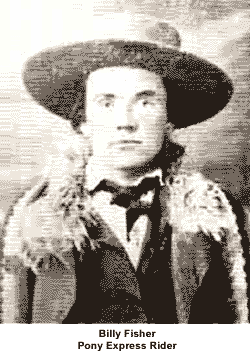The Pony Express was a unique attempt to deliver mail to the American West. Although it only operated for 18 months (April 3, 1860 to November 18, 1861) and bit the dust, the express became a colorful fixture of Western history. Seeking publicity and federal aid for an overland mail service, William H. Russell persuaded William B. Waddell and Alexander Majors to back his Central Overland California and Pikes Peak Express Company, better known as the Pony Express. The firm would carry mail and some small freight for the fledgling Wells Fargo Company between St. Joseph, Missouri, and Sacramento, California.* Senator William M. Gwin of California was the congressional backer of the Pony Express. Russell handled promotion, Waddell was in charge of finances, and Majors was director of personnel. To draw public attention to the central route in hope of winning the $1 million government mail contract for their business, the partners intended to:
The layout and route
The express was a relay. Strong ponies, most averaging 10 miles an hour, cantered between 165 stations at intervals of 10 to 15 miles. Fresh riders and horses were poised at each station to pick up the mail and carry it on. Four hundred horses stocked the Pony Express route. Morgans, mustangs, pintos and thoroughbreds were frequently used. The Pony Express first functioned weekly, then semiweekly, night and day, all four seasons, with 75 ponies participating both ways. Riders might cover 200 miles a day over 10 days. It took less than two weeks to cover the full distance. That was 12 to 14 days shorter than the time required by the Overland Mail. The route of nearly 2,000 miles followed the fabled Oregon-California Trail, along the Platte River in Nebraska, and through South Pass in Wyoming. At Fort Bridger, Wyoming, the riders departed from the trail, proceeded south of the Great Salt Lake, then headed west across the desert to the Sierra Nevada mountains at Carson City, Nevada. The route saved more than 100 miles over the southern route. The stretch between Fort Kearny in Nebraska and Fort Churchill in Nevada was once covered in a record six days. The riders on that occasion bore the news of Abraham Lincoln's election in November, 1860. There were about 400 station keepers and helpers. The isolated employees maintained the facilities and took care of the horses. The riders
A California newspaper advertised the following:
"Wanted. Young, skinny, wiry fellows. Not over 18. Must be expert riders. Willing to risk death daily. Orphans preferred."The riders' ages ranged between a pre-teen boy and a man in his mid-40s. Most riders were in their early 20s. They typically weighed around 120 pounds. Few were orphans. The pay was $100 to $150 a month, handsome for the times.
 As a rider neared a station, the keeper brought out a fresh horse, saddled and ready to travel. The rider alighted from his mount, grabbed the rainproof leather mail pouches, attached them to the saddle, and was back on the trail in about two minutes. Typically, each man rode 75 miles, but if a waiting rider could not carry the mail, the previous rider pressed on.
Riders usually packed just a pair of handguns and a blade to fend off assaults by Indians and robbers. One hundred eighty-three men are known to have ridden for the Pony Express.
The demise
As a rider neared a station, the keeper brought out a fresh horse, saddled and ready to travel. The rider alighted from his mount, grabbed the rainproof leather mail pouches, attached them to the saddle, and was back on the trail in about two minutes. Typically, each man rode 75 miles, but if a waiting rider could not carry the mail, the previous rider pressed on.
Riders usually packed just a pair of handguns and a blade to fend off assaults by Indians and robbers. One hundred eighty-three men are known to have ridden for the Pony Express.
The demiseThe price per half ounce of mail was originally $5, but was later dropped to $1. The Pony Express boosted route town economies, particularly Salt Lake City, but Russell, Waddell, and Majors went bankrupt in 1862. Freight businessman Ben Holladay acquired the Central Overland California and Pikes Peak Express Company at a foreclosure sale in 1862. Although the Pony Express served a need by providing mail service, it was rendered obsolete by the Western Union Telegraph Company and the advent of the transcontinental railroad. The mail was lost only once in the 650,000 miles traveled by the Pony Express.